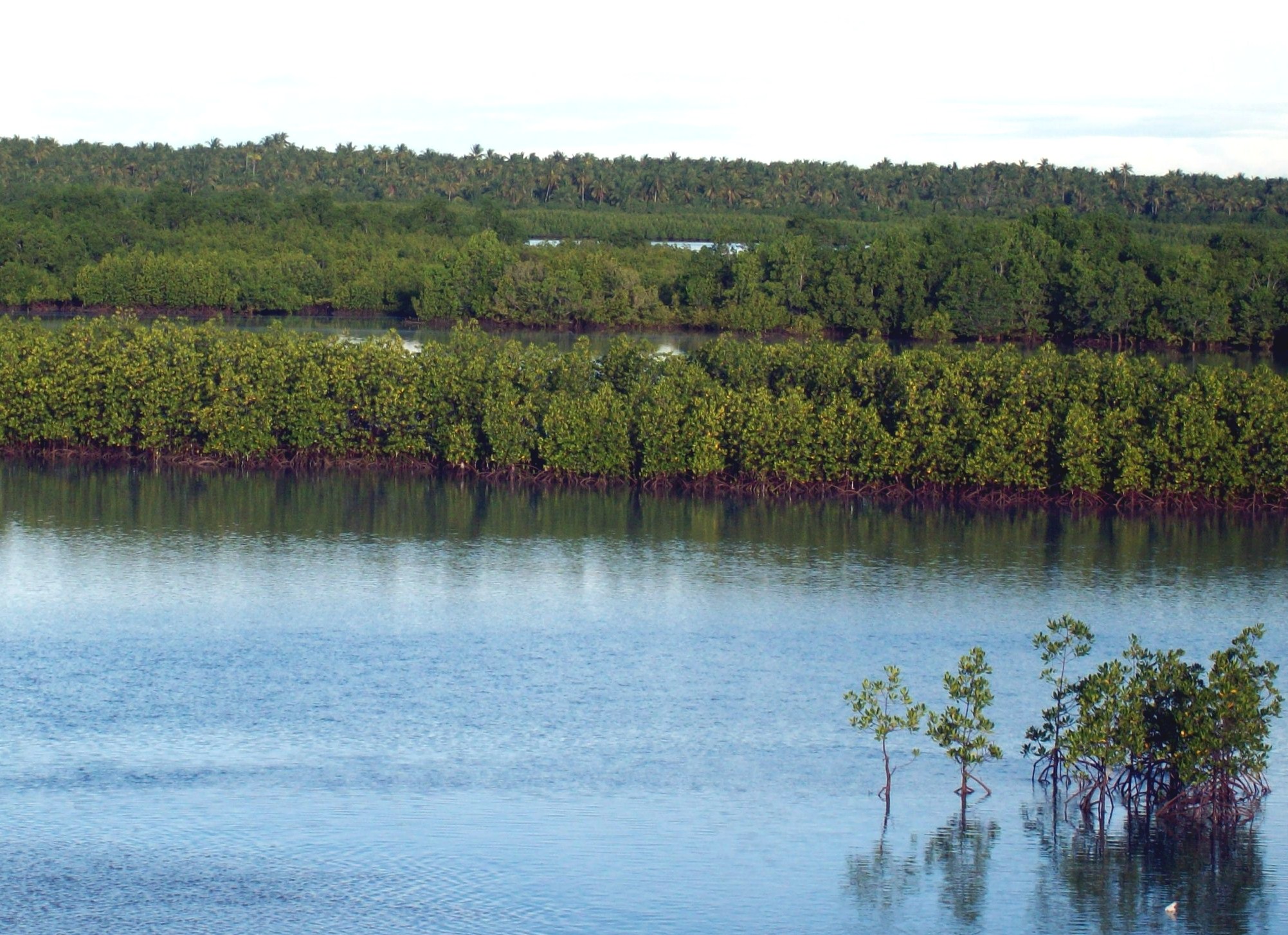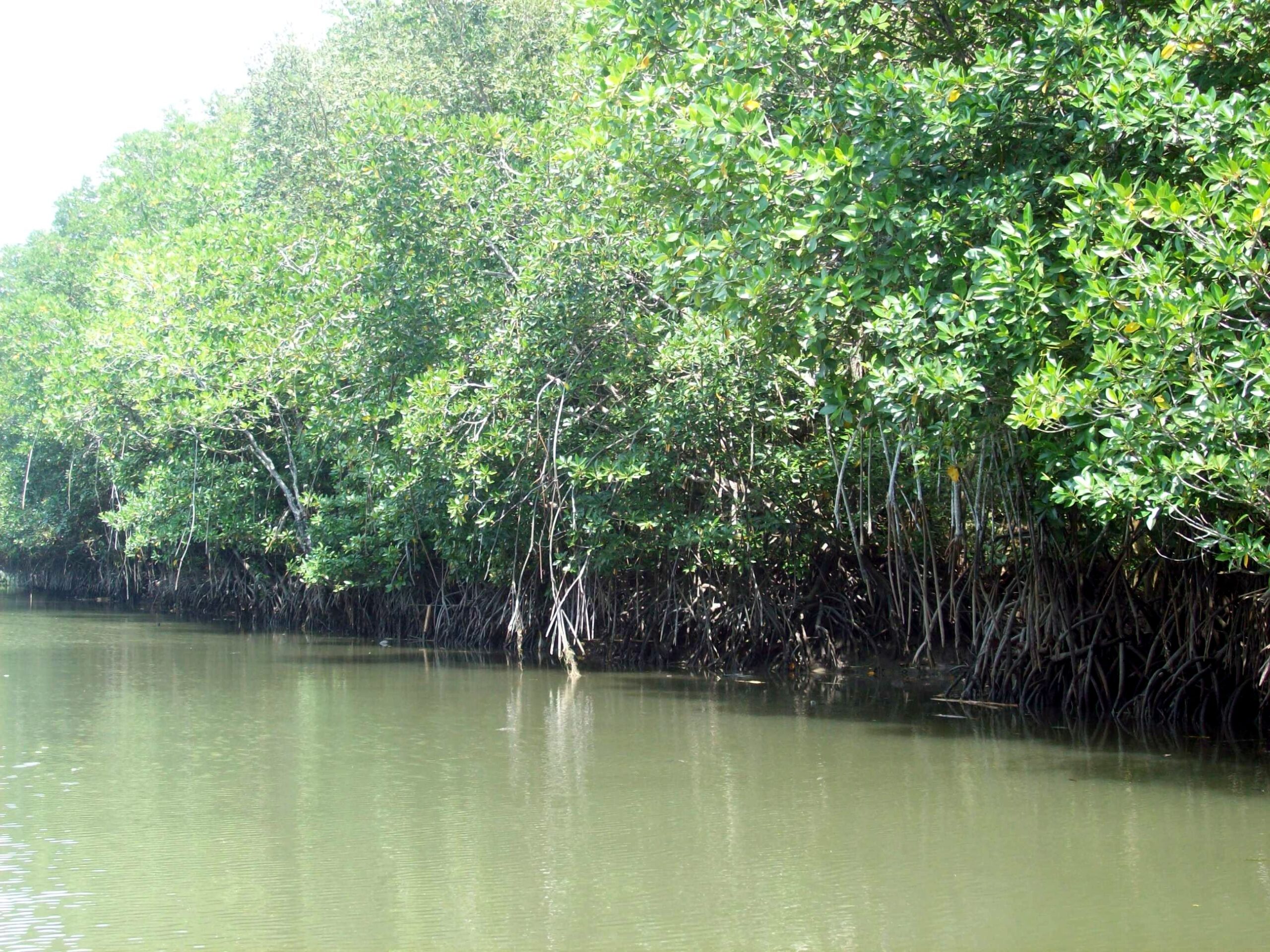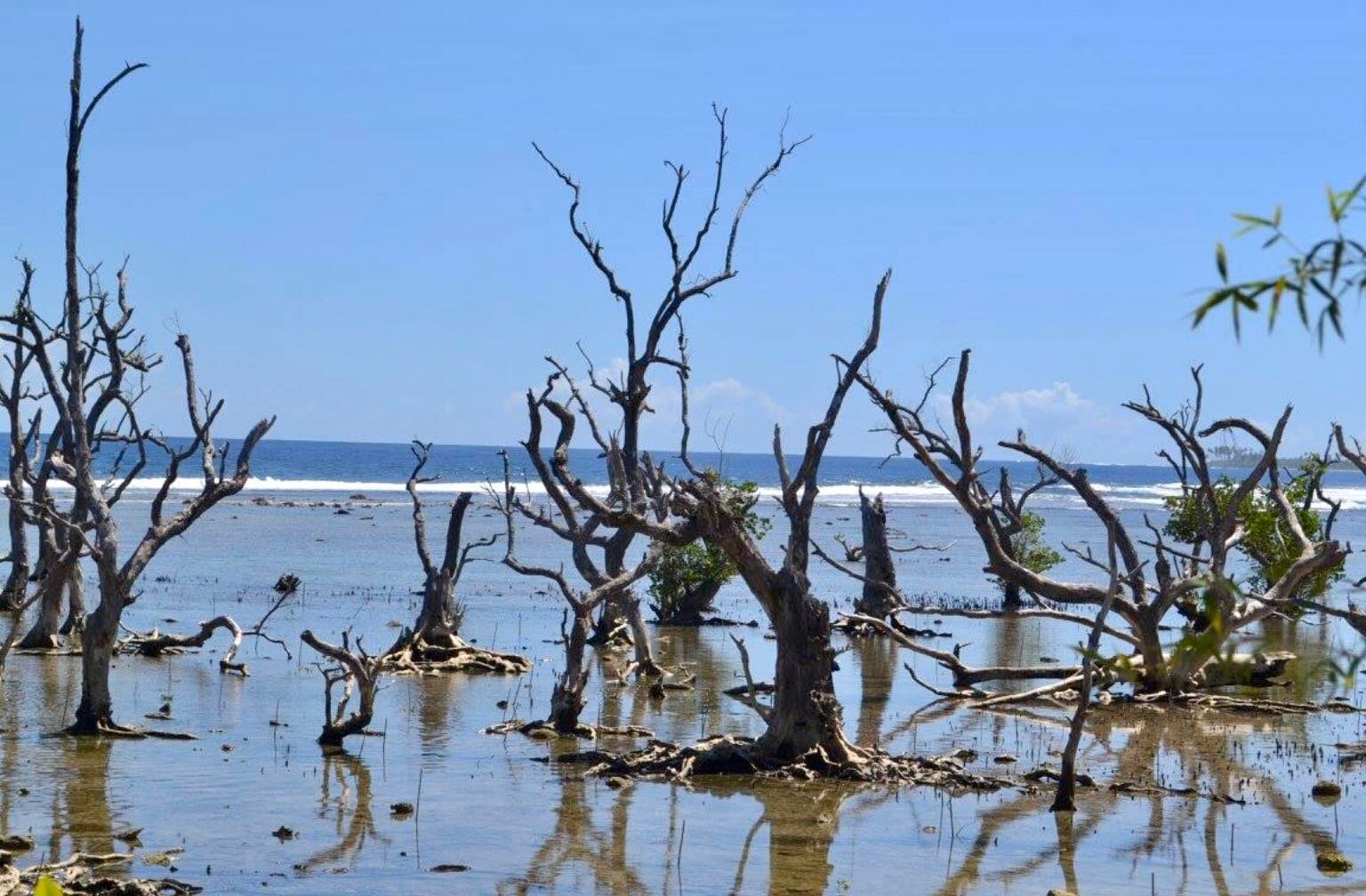Text and Photos by Henrylito D. Tacio
People may consider mangroves – those communities of trees in the tidal flats in coastal waters, extending inland along rivers where the water is tidal, saline, or brackish – as somewhat eerie. After all, they are oftentimes featured in horror films. In some instances, mangroves are areas where murders are done since they are secluded.
But instead of dismissing them as sinister-looking, mangroves can actually save the lives of people living near the coastal areas. Such was the findings of a study by the Visayas State University (VSU).
“Mangroves provided significant protection to communities,” said Dr. Moises Neil Seriño, assistant professor of economics at the VSU who led the study. “Coastal communities with substantial mangrove cover suffered fewer or less casualty and less housing damages as compared to coastal communities with reduced mangrove cover.”
The communities he was referring to were those areas where Super Typhoon Yolanda passed through. Known internationally as Typhoon Haiyan, it was one of the deadliest typhoons on record that hit the Philippines.
“The super typhoon was recorded to first hit land in Guiuan, Eastern Samar then coursed through the island of Leyte. There was widespread devastation in Tacloban City, Leyte from the storm surge brought by the super typhoon. Many buildings and houses were destroyed,” Seriño and his co-authors wrote in their study.
The National Disaster Risk Reduction and Management Council (NDRRMC) confirmed 6,300 fatalities across the typhoon path, with 5,877 fatalities recorded in Eastern Visayas alone. After hitting Eastern Visayas, the super typhoon passed through the northern part of Cebu, then to Panay Island, then to the Busuanga area before exiting the Philippines.
Super Typhoon Yolanda hit the country in 2013. The study was conducted four years later, in 2017. They collected data in these areas: Samar, Leyte, Boho, Cebu, Negros, Panay Island and Palawan.
The study used secondary data collected from municipality offices, Department of Environment and Natural Resources, Municipal Disaster Risk Reduction and Management Council, Municipal Environment and Natural Resources Office, Provincial Environment and Natural Resources Office, Department of Agriculture, and engineering offices.
“We focus on mangroves because mangroves have suffered degradation in the past decades and these mangrove ecosystems have been doing a very important job of protecting coastal communities from damaging effects of typhoons,” said Dr. Seriño.
Records show an average of 20 out of 36 tropical cyclones enter the country’s area of responsibility. “There is no month in the Philippines which is free from typhoons,” said the Philippine Atmospheric, Geophysical and Astronomical Services Administration (PAGASA).
More super typhoons like Yolanda will be entering the Philippines as a result of climate change. The Philippines is facing the Pacific Ocean. Due to climate change, the oceans become warmer, getting more energy to form such types of violent storms.
“The Philippines is in the typhoon prone zone and we can use mangroves as a natural defense against typhoons,” Dr. Seriño pointed out.
Based on the study, the estimated average cost of saving a life by retaining the current mangrove vegetation amounts to as much as P15 million.
“Our study finds significant evidence that the remaining mangrove vegetation reduced the number of deaths and damaged houses during the Yolanda incident,” Dr. Seriño said. “This This property and life-saving effects of mangrove is robust. Mangroves can protect us – our lives, livelihood and properties – from damaging effects of typhoons.”
He urged policy makers to “have additional reason to intensity its efforts in conserving mangrove forests as a long-term strategy in providing protection to coastal communities and better adaptability to typhoon-related disasters.”
A similar study will be conducted for those affected by recent Typhoon Odette, Seriño said.
Mangroves help reduce the impacts of waves, storm surges, and high winds, according to Mark Spalding, Anna McIvor, Gemke Tonneijck, Susanna Tol, and Pieter van Eijk, authors of Mangroves for Coastal Defence: Guidelines for Coastal Managers and Policy Makers.
“Mangroves can rapidly diminish the height of wind and swell waves,” they wrote. “Even during relatively large storm surges, the leaves and branches of the forest canopy will help to reduce wave energy providing the trees are tall enough.”
While storm surge depths may only be reduced by 5 to 50 centimeters per kilometer width of mangroves, “nevertheless a small reduction in water level can already greatly reduce the extent of flooding in low-lying areas behind the mangroves.”
In like manner, the dense mangrove forest canopies can “also reduce wind speeds locally,” the authors explained. “This prevents further development of wind and swell waves in and immediately behind the mangroves, potentially reducing damage to nearby infrastructure.”



In most severe storms, the authors reported that mangroves may themselves be damaged or torn up by high winds and waves, “although breakage or uprooting of mangrove trees is relatively rare.”
Mangroves can even help reduce tsunami damage, as shown during the devastating Indian Ocean tsunami of 2004. “Mangroves reduced tsunami impacts by reducing the destructive energy of water flowing inland,” the authors wrote. “Mangrove belts several hundred meters wide have been shown to reduce tsunami height by between 5% and 30%.”
Sea level rise is another consequence of climate change. Sea levels are rising, experts claim, as a result of the melting of ice sheets and glaciers and the expansion of the oceans as they warm with climate change.
When there are mangroves, lands are created. “Mangroves contribute to an increase in soil volume by capturing riverine or coastal sediments that pass through, as well as adding their own organic matter in the form of roots, leaves and woody material. Due to the waterlogged soil, organic matter is not broken down by soil organisms. This allows the organic matter to build up over time, producing the deep peaty soils that underlie mangroves in some areas,” the authors wrote.
The woody roots of mangroves push the soil upward, resulting in a higher soil level. This allows mangroves to keep pace with rising sea levels. “Some mangroves sit on top of deep layers of mangrove peat that may be 6 meters deep or more, that were built over thousands of years as sea level rose,” the authors wrote.
Studies done from Australia to Belize showed that mangrove soil grew vertically at rates of up to 10 millimeters per year, suggesting that mangroves may be able to keep up with similar rates of sea-level rise into the future.
“With the threats of climate change in the Philippines particularly storm surges, tsunamis, and strong typhoons,” says Dr. Elmer Mercado, a former undersecretary of the Department of Environment and Natural Resources (DENR), “mangrove is the most appropriate, least expensive climate change adaptation protection for our coastal-based communities.”
Instead of building seawalls, Dr. Mercado suggests planting mangroves in areas susceptible to storm surges. By doing so, the government will save money as it is cheaper than building 100-meter of protected seawalls.
Mangrove forest, also known as the “rainforest of the sea,” grows well in tropical countries, including the Philippines. “Mangroves are an important part of the coastal and marine ecosystem that includes the seagrasses and the coral reefs,” reports the environment department.
“There are 25 to 30 species of true mangrove trees and an equal number of associated species,” says Dr. Miguel Fortes, a retired professor of Marine Science Institute at the College of Science of the University of the Philippines in Diliman Quezon City.
Dr. Theresa Mundita Lim, former director of the Biodiversity Management Bureau, says the agency has identified 42 species of mangroves in the country. None of them are facing extinction yet. But the International Union for Conservation of Nature (IUCN) is considering putting 11 out of 70 mangrove species assessed on the IUCN Red List of Threatened Species.
“Mangroves form one of the most important tropical habitats that support many species, and their loss can affect marine and terrestrial biodiversity much more widely,” pointed out Beth Polidoro, who led the first-ever global assessment on the conservation status of mangroves.
“Despite legislation and programs to protect mangroves, the country has lost 75 percent of its mangroves due largely to fishpond development, charcoal production, industrial conversion, reclamation, and pollution,” deplores Dr. Fortes.
The current rate of mangrove deforestation ranges from 2,000 to 3,000 hectares per year, according to Dr. Rafael D. Guerrero III, a national scientist and former head of the Philippine Council for Aquatic and Marine Research and Development.
Recent satellite images analyses indicated that Mindanao has the most mangrove areas in the country (29 percent of the country’s total) while Luzon and Mindoro had the least. Old-growth mangrove forests are mainly found in Mindanao (4,582 hectares) and Palawan (5,317 hectares).
Mangrove forests grow where saltwater meets the shore in tropical and subtropical regions, thus serving as an interface between terrestrial, fresh-water, and marine ecosystems. These forests provide at least US$1.6 billion each year in ecosystem services.
“The loss of mangroves will have devastating economic and environmental consequences,” says Greg Stone, Senior Vice President of Marine Programs at the Washington-based Conservation International. “These ecosystems are not only a vital component in efforts to fight climate change, but they also protect some of the world’s most vulnerable people from extreme weather and provide them with a source of food and income.”
A new study said that mangroves annually reduce property damage by more than US$65 billion and protect more than 15 million people. “If current mangroves were to lose 29% more land, 28% more people and 9% more property would be damaged every year,” said Pelayo Menendez, postdoctoral fellow in the Institute of Marine Science at University of California Santa Cruz and lead author of the study.
Despite the economic and ecological benefits they provide, mangroves are on the verge of disappearance. One environmentalist observes: “All over the country, whatever coastal province you visit, you see the same plight – desolate stretches of shoreline completely stripped of mangrove cover and now totally exposed to the pounding of the ocean’s waves.”
But can those mangroves destroyed by typhoons and other natural calamities be restored again? Dr. Alice Joan G. Ferrer, a professor at the University of the Philippines Visayas, said it’s possible.
“Yes, as evidenced by mangrove areas that naturally regenerate sometime after Yolanda,” she said. “Mangrove experts say to wait for 6 months to see life (new leaves) returns in the mangrove area. The best response after calamities is to allow Mother Nature to heal itself.”
Though mangroves are faced with natural dangers like typhoons, pests and diseases, and rising sea levels due to climate change, “their biggest threats are man-made,” the DENR claims.
Among the human treats cited include conversion of mangroves to fishponds and salt beds; reclamation of mangrove areas for developments such as piers, airports, and housing; pollution and siltation from upland communities; and human disturbances, overexploitation, and utilization, such as overcutting for firewood purposes.
“Sometimes, it is the encroachment of humans to plant or clean after calamity that destroys mangrove areas,” Dr. Ferrer deplored. “Not only we can allow mangroves just before Yolanda to return but also the mangrove areas years before or before their massive destruction in the 1970s to 1980s by focusing on abandoned, underutilized, and underdeveloped fishpond lease areas.”
To prevent further losses of mangroves, lawmakers enacted Republic Act 8550, otherwise known as the Philippine Fisheries Code of 1988, whose section 94 stated that the conversion of mangroves into fishponds or any other purpose is prohibited.
But despite this, mangrove areas in the country are still in peril. “Getting worse,” replies one expert who doesn’t want to be named when asked about the current status of the country’s mangroves. “(The mangroves) remain as the most disturbed among the coastal ecosystems in most places in the country.”

